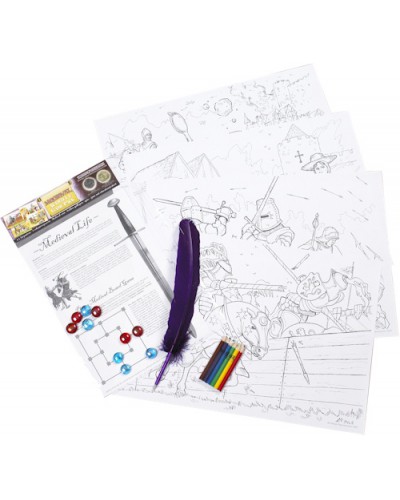Product Description: The Medieval Activity & Game Pack consists of four A3 size colouring sheets, six colouring pencils and a Medieval factsheet with board game and glass beads. Also supplied is a quill pen and a Medieval coin attached to the header card.
The colouring posters include an image of two knights in a jousting battle, an attack on a castle using a catapult, knights in hand-to-hand combat and a poster depicting a medieval town scene. The factsheet, with images, and game board explains about Medieval life, castles, Medieval coins, prices and wages and a quiz. The game board on the sheet together with the provided glass beads is used to play a Medieval game, called Five Men’s Morris. There is a colourful header card that has pictures showing how the posters could be coloured in and has a Medieval coin attached. On the header there is also information about Medieval times and coins.
Information: Many Medieval towns and cities grew around castles and also cathedrals, as their stone wall defences gave good protection against raiders and invaders. Medieval towns were very noisy and crowded by day. Markets were held at least once a week in the square, where stalls were set up and local merchants sold their wares. Fairs that were held once or twice a year would attract strolling minstrels, performing tumblers and animal acts with trained bears.
Tournaments were very popular in the Middle Ages and jousting was often the main event at such festivals. In jousting tournaments, mounted knights would try to unhorse their opponents by striking them with the end of their lance while riding toward them at high speed. This was known as ‘tilting’. The lance was a long pole with a three-pronged tip. Once an opponent was unhorsed, knights would fight on foot. A knight’s sword was his most important weapon but he could also use a club called a mace, a battle-axe or other hand weapons and would carry a shield to ward off blows.
The skills and techniques used in jousting were also in combat. Medieval knights would fight each other wearing protective armour and chain mail. When in battle, a knight would wear his personal heraldic coat-of-arms to enable him to be recognised. Medieval armies consisted of knights, both mounted and on foot, spearmen and archers using crossbows and longbows. The longbow was more difficult to master but a trained bowman could fire up to 12 arrows a minute. The crossbow took a long time to load but was the most deadly, firing a steel bolt, which could pierce full armour from 275 metres.
Five Men’s Morris is an abstract strategy board game for two players that emerged from the Roman Empire. The game is also known as Mills, Merels, Merelles, and Merrills in English and was very popular during the medieval period.
There are many different variations of this game which include three, six, seven, nine, eleven and twelve men’s Morris. Games like this have been found carved into the cloister seats of English cathedrals at Canterbury, Gloucester, Norwich, Salisbury and Westminster Abbey. Another board is carved into the base of a pillar in Chester Cathedral.
Medieval castles were private fortresses built for the King or lord who owned the surrounding lands. In the Middle Ages, besieging armies used a wide variety of siege engines to gain entry to these castles, including scaling ladders, battering rams, siege towers and various types of catapult. When a castle was attacked, the defenders needed enough reserves of food and water to withstand a siege, which could often last weeks or even months. Many castles had their own wells which supplied water during a siege.
The most common coin used during the early medieval period was the silver penny. It was not until trade expanded during the 14th century that new, more valuable, coins were minted like the silver groat and gold noble. Money was calculated in pounds, shillings and pence. 12 pence = a shilling and 20 shillings = a pound. There were no coins equal to pounds and shillings until the reign of the Tudor King Henry VII.

